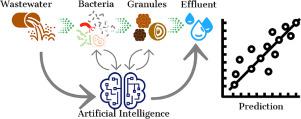Water Research ( IF 11.4 ) Pub Date : 2020-11-19 , DOI: 10.1016/j.watres.2020.116657 Mohamed Sherif Zaghloul , Oliver Terna Iorhemen , Rania Ahmed Hamza , Joo Hwa Tay , Gopal Achari

|
Machine learning models provide an adaptive tool to predict the performance of treatment reactors under varying operational and influent conditions. Aerobic granular sludge (AGS) is still an emerging technology and does not have a long history of full-scale application. There is, therefore, a scarcity of long-term data in this field, which impacted the development of data-driven models. In this study, a machine learning model was developed for simulating the AGS process using 475 days of data collected from three lab-based reactors. Inputs were selected based on RReliefF ranking after multicollinearity reduction. A five-stage model structure was adopted in which each parameter was predicted using separate models for the preceding parameters as inputs. An ensemble of artificial neural networks, support vector regression and adaptive neuro-fuzzy inference systems was used to improve the models’ performance. The developed model was able to predict the MLSS, MLVSS, SVI5, SVI30, granule size, and effluent COD, NH4-N, and PO43− with average R2, nRMSE and sMAPE of 95.7%, 0.032 and 3.7% respectively.
中文翻译:

一套完整的机器学习算法以模拟好氧颗粒污泥反应器
机器学习模型提供了一种自适应工具,可预测在变化的运行和进水条件下处理反应器的性能。好氧颗粒污泥(AGS)仍然是新兴技术,并且没有大规模应用的悠久历史。因此,该领域中缺乏长期数据,这影响了数据驱动模型的开发。在这项研究中,使用从三个基于实验室的反应堆收集的475天数据,开发了一种机器学习模型来模拟AGS过程。在多重共线性减少后,根据RReliefF等级选择输入。采用五阶段模型结构,其中每个参数使用先前参数作为输入的单独模型进行预测。人工神经网络的集合,支持向量回归和自适应神经模糊推理系统被用来改善模型的性能。开发的模型能够预测MLSS,MLVSS,SVI如图5所示,SVI 30,粒度和流出的COD,NH 4 -N和PO 4 3-的平均R 2,nRMSE和sMAPE分别为95.7%,0.032和3.7%。











































 京公网安备 11010802027423号
京公网安备 11010802027423号